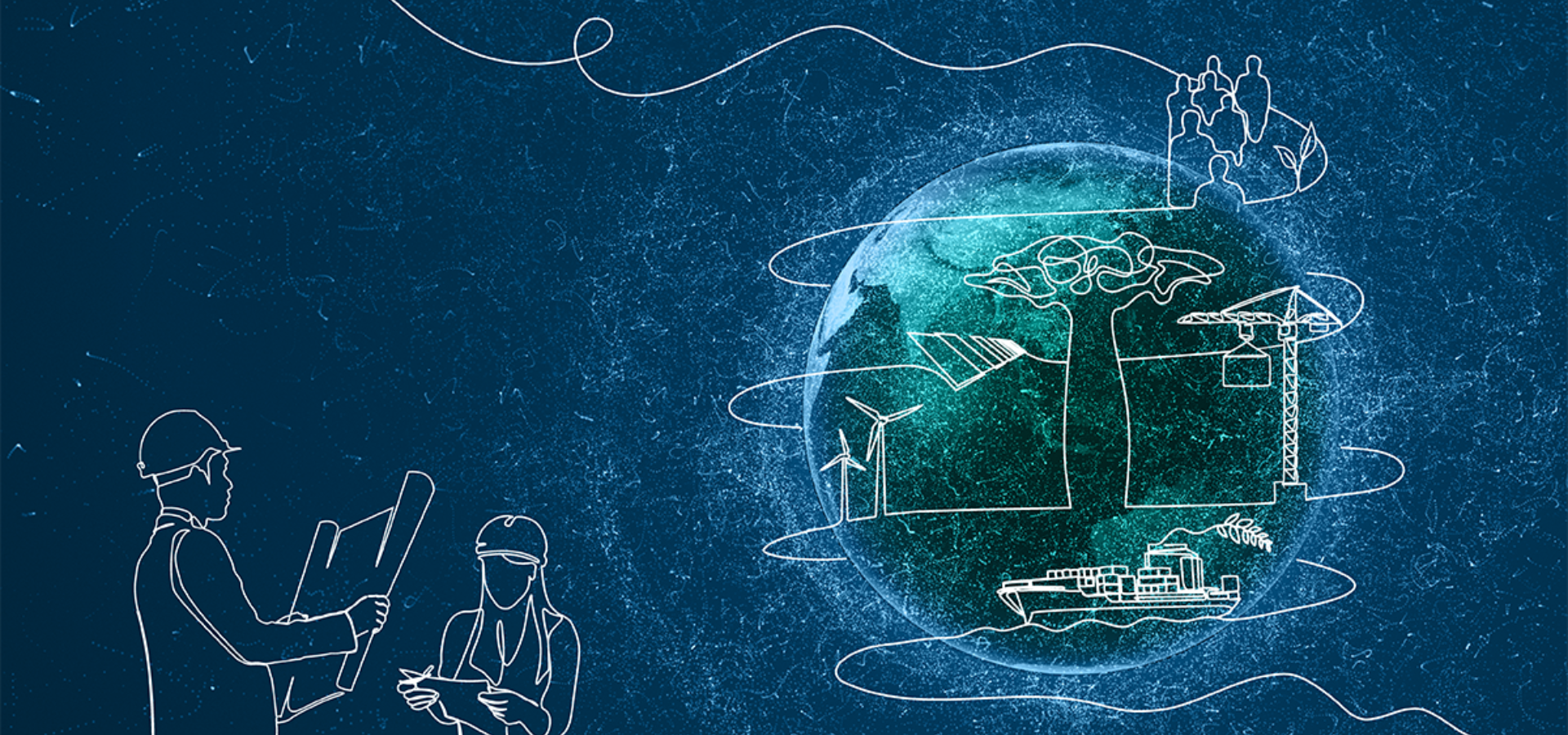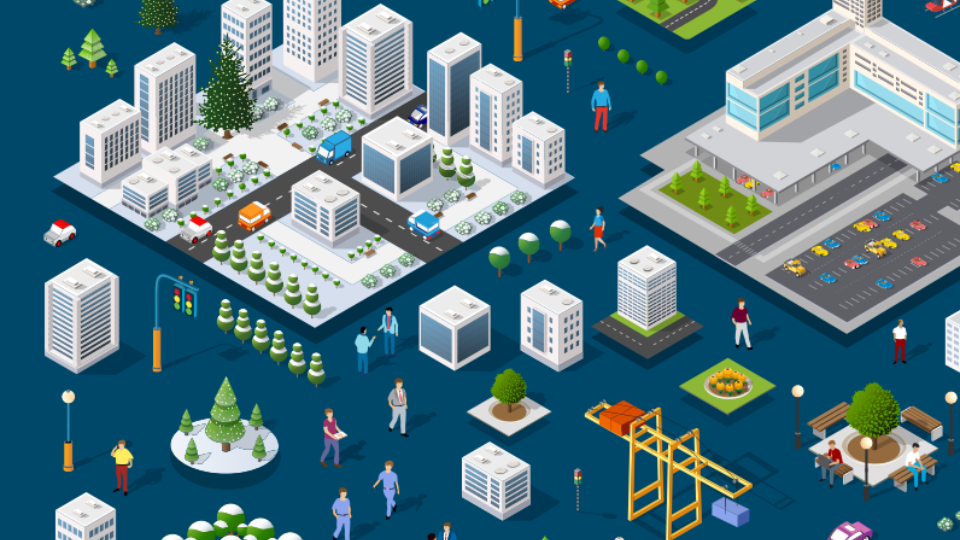The United Nations Office for Project Services (UNOPS)
Beyond targets: How UNOPS is driving climate action

From ambitious emissions targets to innovative pilot projects, discover how UNOPS is turning climate commitments into tangible action.
Climate change is not just a distant threat, it’s one of the most pressing challenges facing humanity today. It poses severe risks to all life on Earth – a crisis multiplier that jeopardizes our health and well-being, as well as livelihoods, global stability and the very future of our planet.
Together, the global community must act urgently to mitigate the impacts of climate change and advance a just transition to sustainable, low-carbon economies.
With a commitment to helping bridge the implementation gap between climate ambition and climate action, UNOPS can play a critical role in mitigation and adaptation efforts, advancing the transition and creating a more sustainable future for all – starting with our own practices.
Our Senior Climate Analyst, Vanja Wylie, joins UNOPS Insights to discuss ways that the organization is walking the walk and driving meaningful climate action across the organization.
1. The world is facing a climate crisis. What is UNOPS doing to address it?
UNOPS is committed to tackling the climate crisis on multiple fronts and has a key role to play in helping people, communities and governments to prevent climate change and reduce our negative impact through our projects and engagements. The Paris Agreement aims to limit global warming to 1.5 degrees Celsius. To achieve this, we all need to drastically reduce emissions.
As a large organization with a global presence, we have a responsibility to ‘walk the walk’ and lower our emissions. By fostering collaboration, empowering regions with the tools and expertise they need, and aligning our operations with global sustainability frameworks – like the Paris Agreement – we can transform climate commitments into tangible action.
2. Are there any updates on these climate initiatives?
UNOPS has made important strides, but there's always more to do. We recognize the urgency of the climate crisis and the need for ambitious action. At COP28, we announced our commitment to a 45 per cent reduction in our own operational emissions by 2030 (covering everything from our offices to our business travel), and are committed to being net-zero by 2050.
To help achieve this, we launched our Climate Action Programme in 2024 and developed a comprehensive climate strategy. We are also assessing climate risks and emissions across our organization to gather data.
But the decentralized nature of UNOPS presents a challenge. While many regions are actively implementing climate initiatives, we need to improve knowledge sharing and coordination to maximize our collective impact. We're working on mapping regional efforts to gain a clearer picture and ensure everyone has the support they need to contribute effectively. This increased collaboration and momentum across UNOPS is critical for achieving our ambitious goals.
3. What is the UNOPS Climate Action Programme?
The UNOPS Climate Action Programme is our organization-wide effort to help tackle the climate crisis. In addition to our COP28 commitments, we have set ambitious goals like integrating climate risk assessment into 100 per cent of our infrastructure projects.
The programme unites our efforts, providing a shared understanding of our climate goals and a common path forward, ensuring everyone in UNOPS is working together. It empowers action by helping us tailor our approach to the unique challenges and opportunities in different regions. And it helps measure our progress, providing estimates of the costs involved in reaching our targets, allowing us to track our progress and make informed decisions.
4. What concrete steps is UNOPS taking to implement the Climate Action Programme and achieve its ambitious goals?
The Climate Action Programme is our roadmap to a more sustainable future. It provides a clear strategy for achieving our ambitious climate targets.
Setting targets is a crucial first step; now it’s time for action. Our biggest challenge is tackling Scope 3 emissions, which account for 99 per cent of all UNOPS emissions. Since these are indirect emissions from our value chain, including from our suppliers and partners, our key priority is to empower and equip our regional teams with the tools and resources they need to enable real change on the ground. This is where we create lasting impact.
A central part of our approach is focused on supplier engagement. We’re developing a supplier engagement strategy that includes a supplier prioritization tool, enhanced climate-related resources in our Supplier Resource Centre and specialized training for teams around the world. This will help empower our suppliers, especially in less mature markets, to actively reduce emissions and build climate resilience
We’re also working closely with our partners, especially governments, to ensure our projects align with national climate plans. By collaborating effectively, we can make a strong case for prioritizing climate considerations in every project.
5. Can you give us an example of a country office that is taking positive steps towards climate action?
Our Nicaragua office has developed a methodological framework to incorporate climate considerations into project planning, centred on a five-dimensional transition model: sustainability, mitigation, adaptation, resilience and compensation. Although it's still in the initial phases, they are working to systematically implement the framework in all of their projects and they have been successful in implementing the climate methodology for a range of both infrastructure and procurement projects. The country team has developed the framework and put it into action with limited resources, and it's very much contextualized to the country's situation.
For one project, the project team collaborated with the logistics provider to estimate the emissions generated from the transportation of procured goods. Based on this, they looked for opportunities to reduce emissions.
6. A key part of the Climate Action Programme is the climate strategy. What are some of the takeaways from UNOPS climate strategy?
Our climate strategy charts a clear course for UNOPS to minimize our environmental impact and contribute to a more sustainable future. It is our commitment to significantly reduce our own emissions. But it goes much further. We've carefully assessed the climate risks facing our offices and project locations around the world. This allows us to prioritize action in areas most vulnerable to climate change impacts like drought, flooding and extreme weather.
To truly understand our impact, we further analyzed our entire value chain – everything from the materials we use and our procurement assets to the long-term effects of our projects. This revealed that the construction, use and eventual demolition of our infrastructure projects represent a significant portion of our emissions.
Finally, the strategy establishes a clear governance structure and monitoring system to ensure we stay on track and achieve our goals. This strategy is about more than just reducing our own (negative) impact. It's about integrating climate considerations into everything we do, helping our partners build resilience and contributing to a more sustainable future for all.
To be clear, climate is not a standalone initiative within UNOPS. We are working to tightly integrate it into all our processes, in our own operations as well as our projects – from the opportunity stage to monitoring and evaluation. This requires our systems and our data to evolve to be able to enable, track, monitor and promote climate change. Overall, climate will be seamlessly integrated into our system to facilitate our work across the globe.
7. Can you tell us about some pilot projects taking place at UNOPS?
To pinpoint where we can make the biggest difference, we started 2024 with a deep dive into our procurement activities. We analyzed our spending and the environmental impact of different goods and services, identifying five key categories: transportation, energy, ICT equipment, infrastructure and medical supplies.
We began with ICT equipment and have launched several exciting initiatives. We joined the Circular and Fair ICT Pact, a global network that provides guidance and support for sustainable procurement in this sector. We're also developing guidelines and minimum requirements for procurement of ICT equipment that prioritize eco-friendly options, promote longer lifespans and encourage responsible disposal. These requirements will be integrated into our existing Sustainable Procurement Framework Guidance and Resource Tool as well as UNOPS global e-Commerce solution, UN WebBuy Plus.
Our focus on ICT stems partly from a successful pilot project implemented in Argentina. On behalf of the government, UNOPS procured 40,000 laptops which included strong climate considerations, such as local assembly, energy efficiency, sustainable packaging and a commitment to measuring the laptops' carbon footprint. Through our DRiVE programme, which helps us engage with suppliers on sustainability issues, we were able to work with vendors to meet these requirements and even helped one achieve an environmental certification. This pilot has been a valuable learning experience, and we're now building on this success in the second round of the project, incorporating even more climate-friendly practices.
8. Some might argue that the actions of a single organization can't turn the tide of the climate crisis. Why do UNOPS efforts matter?
In the face of the escalating climate crisis, UNOPS has a unique opportunity – and responsibility – to drive meaningful change.
The time for incremental change is over. The climate crisis demands bold action, and UNOPS is stepping up to the challenge. I believe that every project, every initiative, every action, no matter how small, can contribute to a more sustainable future. The future of our planet depends on it.
Vanja Wylie
Vanja Wylie is a Senior Climate Analyst in the Procurement Group working within the Sustainable Supply Chains team. She is also part of the core Climate Action Programme team that developed the UNOPS climate strategy.













